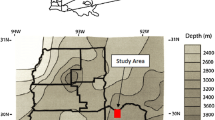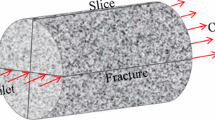Abstract
The use of \(\hbox {CO}_{2}\) as a heat transfer fluid has been proposed as an alternative to water in enhanced geothermal systems (EGS) and in \(\hbox {CO}_{2}\)-plume geothermal systems (CPG). Numerical simulations have shown that under expected EGS operating conditions, \(\hbox {CO}_{2}\) would achieve more efficient heat extraction performance compared to water, especially at sites with low geothermal temperatures and low subsurface heat flow rates. With increased interest in carbon capture and sequestration (CCS), the possibility of combining geothermal energy production with carbon sequestration is actively being explored. Simulations have shown that \(\hbox {CO}_{2}\)-based geothermal energy production could substantially offset the cost of CCS. Since numerical models are critical for the planning and operation of geothermal systems that employ \(\hbox {CO}_{2}\) as the working fluid, it is important to validate the results of the current numerical tools against real- world experimental data. In a set of laboratory experiments, we have investigated heat extraction by flowing dry supercritical \(\hbox {CO}_{2}\) through a heated porous medium in a laboratory pressure vessel and have compared experimental results with a numerical model using TOUGH2 with the ECO2N module. In addition, experiments were performed using (1) \(\hbox {CO}_{2}\) and (2) water as the working fluids under similar operating conditions in order to compare the heat transfer behavior and the overall heat extraction rates. Our laboratory apparatus is capable of operating at temperatures up to 200 \(^{\circ }\hbox {C}\), pressures up to 34.5 MPa, and flow rates up to 400 ml/min. The experimental system was designed such that measurements and controls at the boundaries could be readily modeled using TOUGH2. We have made estimates of the density and the effective thermal conductivity of our saturated porous media, and have found that both properties change significantly during the course of experiments. The large changes in \(\hbox {CO}_{2}\) density, due to decreasing system temperatures, can result in fluid accumulation in the system that may have significant impacts on geothermal reservoir management. The large changes in thermal conductivity as a function of temperature are of concern because the TOUGH2 code does not update the thermal conductivity of the system during the course of a simulation. Our data can be used by geologic reservoir modelers to ensure that their models accurately capture the heat extraction behavior of \(\hbox {CO}_{2}\) to aid in the further investigations of EGS, CPG, and CCS.












Similar content being viewed by others
References
Brown, D.W.: A hot dry rock geothermal energy concept utilizing supercritical \(\text{ CO }_{2}\) instead of water. In: Proceedings of the Twenty-Fifth Workshop on Geothermal Reservoir Engineering, Stanford University, pp. 233–238 (2000)
Eastman, A.D., Muir, M.P., Energy, G.: CO\(_{2}\) EGS and the utilization of highly pressurized \(\text{ CO }_{2}\) for purposes other than power generation. In: Proceedings of the Twenty-Eighth Workshop on Geothermal Reservoir Engineering. Stanford University (2013)
King, S., Beck, F., Lüttge, U.: On the mystery of the golden angle in phyllotaxis. Plant Cell Environ. 27.6, 685–695 (2004)
Kunii, D., Smith, J.M.: Heat transfer characteristics of porous rocks. AIChE J. 6(1), 71–78 (1960)
Lemmon, E.W., McLinden, M.O., Friend, D.G.: Thermophysical properties of fluid systems. NIST chemistry WebBook, NIST standard reference database number 69. In: Linstrom, P.J., Mallard, W.G. (eds.) National Institute of Standards and Technology, Gaithersburg MD, http://webbook.nist.gov, (retrieved September 2010)
Liao, S.M., Zhao, T.S.: Measurements of heat transfer coefficients from supercritical carbon dioxide flowing in horizontal mini/micro channels. J. Heat Transf. 124.3, 413–420 (2002)
Majer, E.L., Baria, R., Stark, M., Oates, S., Bommer, J., Smith, B., Asanuma, H.: Induced seismicity associated with enhanced geothermal systems. Geothermics 36.3, 185–222 (2007)
Powell, R.W., Ho, C.Y., Liley, P.E.: Thermal conductivity of selected materials. (No. NSRDS-NBS-8). In: National Standard Reference Data System (1966)
Pruess, K.: The TOUGH codes—a family of simulation tools for multiphase flow and transport processes in permeable media. Vadose Zone J. 3, 738–746 (2004)
Pruess, K.: Enhanced geothermal systems (EGS) using \(\text{ CO }_{2}\) as working fluid—a novel approach for generating renewable energy with simultaneous sequestration of carbon. Geothermics 35(4), 351–367 (2006)
Pruess, K.: Enhanced geothermal systems (EGS) comparing water with \(\text{ CO }_{2}\) as heat transmission fluids. In: Proceedings, New Zealand Geothermal Workshop 2007 Auckland, New Zealand (2007)
Pruess, K., Spycher, N.: ECO2N—a fluid property module for the TOUGH2 code for studies of storage in saline aquifers. Energy Convers. Manag. 48.6, 1761–1767 (2007)
Randolph, J.B., Saar, M.O.: Coupling carbon dioxide sequestration with geothermal energy capture in naturally permeable, porous geologic formations: implications for \(\text{ CO }_{2}\) sequestration. Energy Procedia 4, 2206–2213 (2011). doi:10.1016/j.egypro.2011.02.108
Tester, J.W., Anderson, B., Batchelor, A., Blackwell, D., DiPippo, R., Drake, E., Garnish, J., Livesay, B., Moore, M.C., Nichols, K., Petty, S., Toksoz, N., Veatch, R., Augustine, C., Baria, R., Murphy, E., Negraru, P., Richards, M.: The future of geothermal energy: impact of enhanced geothermal systems (EGS) on the United States in the 21st century. In: Massachusetts Institute of Technology, DOE Contract DE-AC07-05ID 14517 Final Rept., p. 374 (2006)
Woodside, W.T., Messmer, J.H.: Thermal conductivity of porous media. I. Unconsolidated sands. J. Appl. Phys. 32.9, 1688–1699 (1961)
Author information
Authors and Affiliations
Corresponding author
Rights and permissions
About this article
Cite this article
Magliocco, M.J., Glaser, S.D. & Kneafsey, T.J. Laboratory and Numerical Studies of Heat Extraction from Hot Porous Media by Means of Supercritical \(\hbox {CO}_{2}\) . Transp Porous Med 108, 85–104 (2015). https://doi.org/10.1007/s11242-015-0474-0
Received:
Accepted:
Published:
Issue Date:
DOI: https://doi.org/10.1007/s11242-015-0474-0




